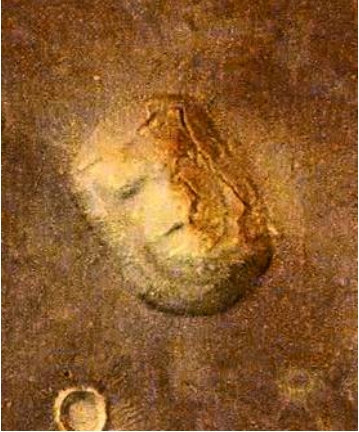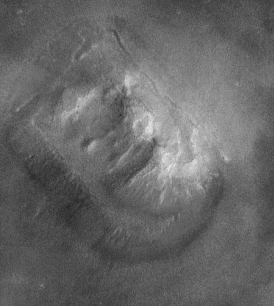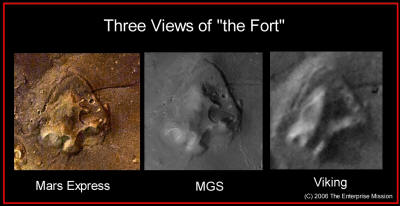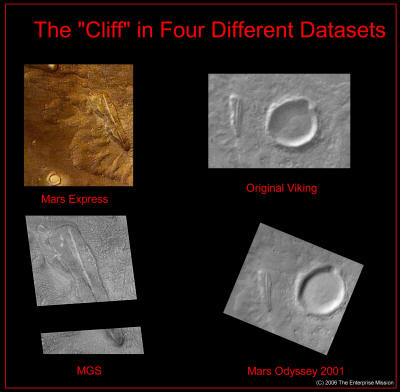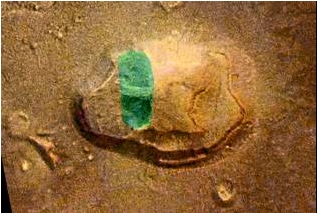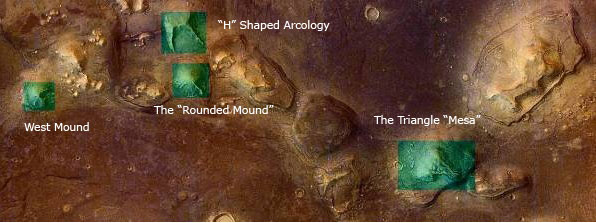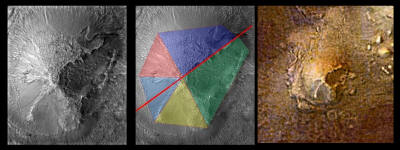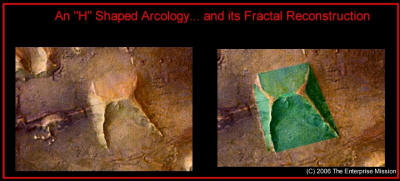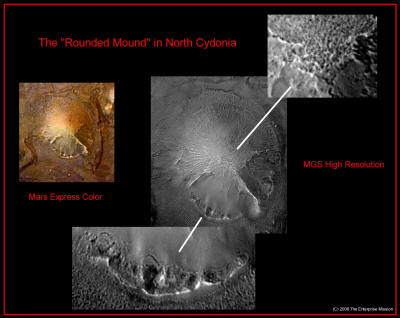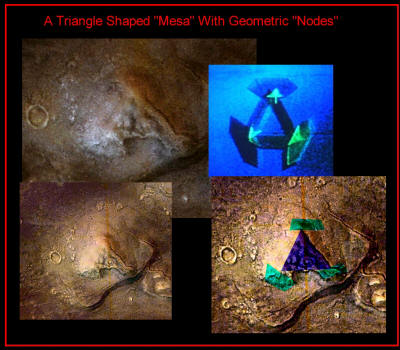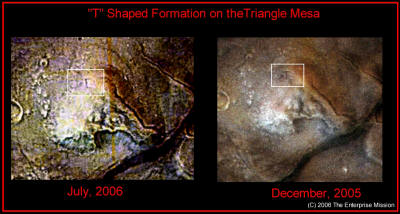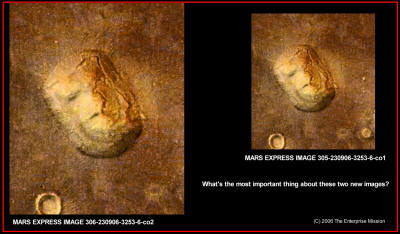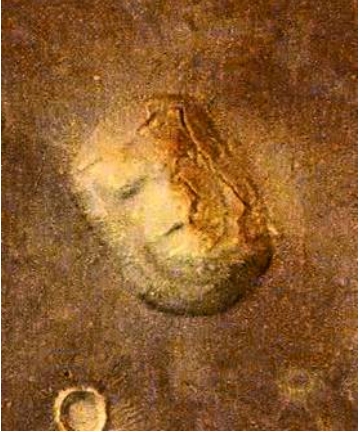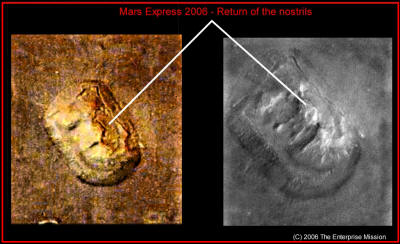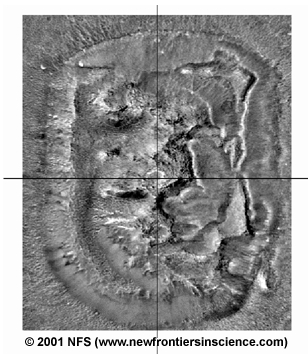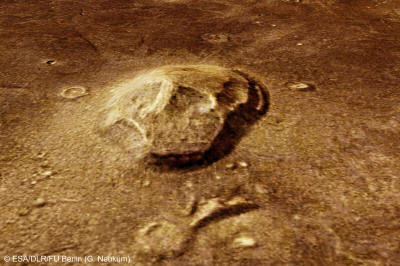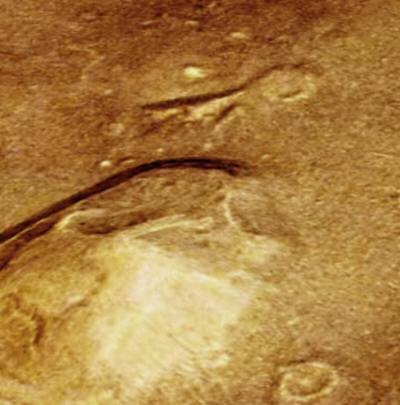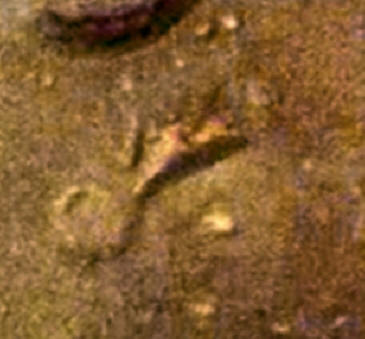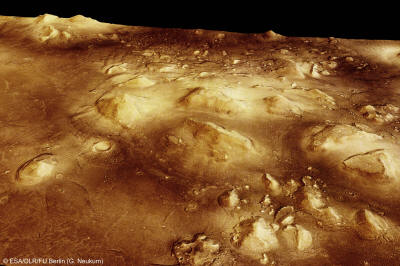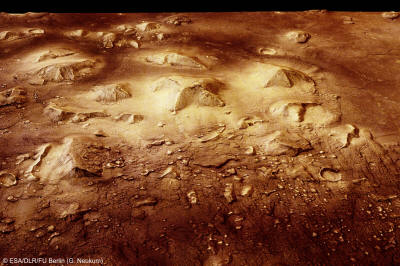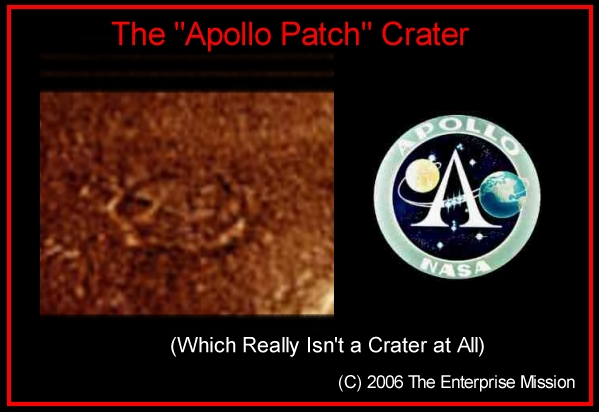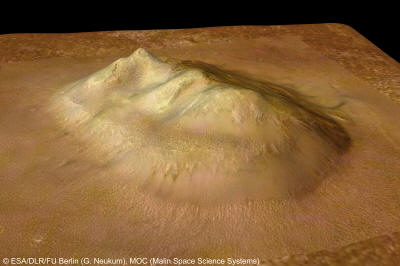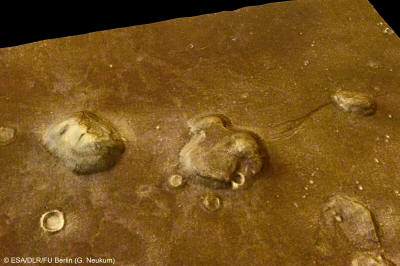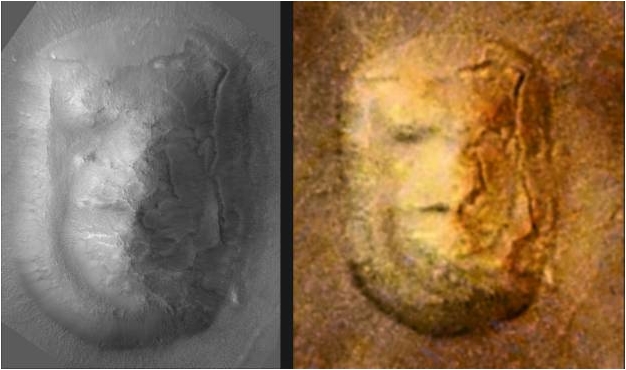|
Gee, what a surprise.
Further, all kinds of conditions - atmospheric haze, lighting (sun) angles,, camera settings, the optical properties of the camera, the filters being used, the incidence angle of a nadir-pointing camera - can all dramatically affect the quality of the resulting image.
A good case in point would be the infamous “Catbox” image of the Face on Mars.
The example above is the so-called “TJP enhancement” of the “Catbox” image of the Face, taken in 1998. While it is unquestionably the best enhancement of this image to date, it is of very poor quality.
According to the Malin Space Science Systems website, the image has a spatial resolution of 4.3 mpp, making it by far the best image of the Face to that point. However, this stated resolution only takes into account the maximum possible resolution, based on the camera optics and the altitude above the target.
The image was in fact taken after the spacecraft had already passed over the Face, from a 45 degree angle to the west, and with the sun at a fairly low morning sun angle of 25 degrees above the horizon, lighting the Face from below. In addition, MSSS had stripped out at least 50% of the data by using an exceptionally large image swath (see “Honey, I shrunk the Face” 1998), and haze and cloud cover made for very poor lighting conditions.
The result was an extremely dark, low
contrast image which didn’t come close to the imaging capabilities
of the MGS camera. Vince Dipetro, an early pioneer of Face research,
concluded that with all the factors included, the effective spatial
resolution of the image was 14 mpp, as opposed to the stated 4.3 or
the optimum 1.2 mpp capability of the camera under ideal conditions
and altitude.
The first image (305-230906-3253-6-co1) provides the added bonus of capturing the Cliff in the lower portion of the frame, and a substantial amount of the anomalous “mesas” north of the Face first noted by Hoagland in Monuments. What this all amounts to is that these images are without a doubt the best wide-angle view we have ever gotten of Cydonia.
So, that said, what
do they tell us?
The Mars Express color image is by far the most detailed view of this object yet, despite the fact that the grayscale MGS image has a higher theoretical spatial resolution. The D&M Pyramid, just a few miles south of the Face, is yet another example of this color phenomenon.
While the composite MGS view shows more close-up detail, the Mars Express image shows the object in much better context, emphasizing the strange circular platform from which it rises some 2500 feet above the plain below.
The Mars Express image is also dramatically better than the Mars Odyssey 2001 visual camera image, showing more detail than can be discerned in that grayscale image while losing none of the critical context. But perhaps no member of the existing “Cydonia complex” is revealed as more alien than the curiously straight edged “Cliff.” First noted by Hoagland back in the early days of the Cydonia investigation, the Cliff is an anomalously straight ridge seemingly perched atop the ejecta blanket of a nearby crater. It formed, along with the apex of the tetrahedral “Tholus” and the rim pyramid of the nearby crater, one of the key 19.5 alignments in Cydonia Geometric Relationship Model.
The argument for its possible artificiality has always centered around the fact that it has not only a completely bizarre geomorphology (a near-perfectly straight ridge running for miles) but that it rested on a raised platform of sorts which seemed to post-date the crater impact. Later high resolution images from Mars Global Surveyor, Mars Odyssey 2001 and now Mars Express seem to support this.
There is no evidence that the ejecta has
spattered on top of the Cliff, and the entire mesa just seems to
have been stamped on top of the ejecta flow. After more than a
generation, the conclusion that this anomalously straight ridge
somehow posted-dated the cratering event (which is a geological
impossibility) is more than solid.
This image showed that what appeared in the Viking data to be simply a natural mesa among the ruins of Cydonia was in fact an intriguingly symmetrical mesa. The odd ESA description of it as “skull shaped” is attributed to the claim (by ESA) that some people have referred to it as such. In fact, we have never encountered this description in any anomaly related web article or public posting.
The “mesa” in question has caught our
fancy for several reasons; its significant symmetry, its proximity
to a massive tetrahedral ruin noted by Hoagland in 1998, and the
existence of a tunnel or channel terminating at the exact lateral
center of the “mesa” in the Mars Odyssey infrared data. Our own
conclusion is that the skull reference is a designed distraction, to
keep readers from viewing it from a perspective that makes the
symmetry obvious.
Essentially, the concept of a fractal is that a given object resembles itself at different levels of magnification. For instance, the Face on Mars still looks like a Face at both lower resolution (Viking) and higher resolution (MGS). With fractal erosion, the concept is taken a step further to predict that a given object generally erodes along the lines of its original shape. So we can reconstruct the original shape of a given object by studying how it appears today.
Using this method, architect Robert Fiertek did a study of the original shape of the City at Cydonia in the early 1990’s.
We can do a similar reconstruction with various objects around Cydonia. Doing so, the “skull shaped mesa” becomes more overtly symmetrical, and the original shape of a number of objects in the north become highly geometric.
This area, dubbed “Super Bowl City” by researcher Robert Harrison of the Cydonia Quest web site, was first noted by Hoagland in Monuments. It contains a wealth of geometric ruins that are nearly inexplicable by natural erosive processes.
In fact, all of the “mesas” in this particular area are very unusual, but the four we have selected seem to be the most non-natural and the most consistent with the other anomalies at Cydonia.
Four especially anomalous objects north of the Face
The West Mound, and
“H” shaped structure, a Rounded Mound, and a Triangular Mesa The far left object, dubbed the “West Mound” by Harrison, is remarkably similar to other objects at Cydonia like the D&M and Main Pyramid in the City. It appears to have a degree of symmetry about a central axis that is highly unusual for any natural erosion process. Close up MGS views reveal blocky, room sized geometric patterns on its more eroded flanks, where it appears the original exterior structure has collapsed inward.
Were this object part of the original “City” it would certainly have been included as a candidate for artificiality, and would certainly have passed the test upon closer inspection.
Three views of the
West Mound (Harrison\Bara) Just a short distance from the West Mound are two more objects that really defy conventional explanation. One is a bizarre “H” shaped formation. Once again we see the unaccountable symmetry of a “mesa” in Cydonia, this time in the shape of an “H.” The Fractal reconstruction shows it was once a wedge shaped structure, probably a hollow arcology which has collapsed inward around an “H” shaped frame.
The superstructure is clearly sagging
and caving inward, but just as obviously it was once a far more
robust and majestic building. Directly adjacent is what looks to be
a bulging “bunker” with a vertical face and what could be judged as
entrances. Assuming the reconstruction is valid (and it would seem
to be obvious), then these two adjacent structures would easily be
deemed artificial. If they appeared on images anywhere on Earth, it
is doubtful that their artificiality would be at all questionable.
In the color images, a distinct “moat” can be seem around the circumference of the mound, indicating it has sunk at least partially into the surrounding terrain. Close-ups done by Harrison show that there are large pits or sinkholes around the base of the structure, implying that it is settling into a hollow or collapsing inward from the base into a hollowed out interior.
Obviously, neither of the characteristics is consistent with a naturally eroding object, unless it is some bizarre example if volcanism which forms with air pockets inside. This notion is pretty quickly dispelled by looking at the exposed upper surfaces of the mound, which display the all-too familiar rectangular “room sized cells” where the casing structure appears to have been worn away.
This is consistent with observations
from the D&M and the so-called “main pyramid” in the City.
This “mesa” is as anomalous as it gets, and for Cydonia, that’s saying something. As we get into the details of the Triangle Mesa, there is even more strangeness. Just to the left of the northernmost node is a very odd dark feature which appears in both the December 2005 and July 2006 datasets – a distinct “T.” This very dark marking on the structure is not only aligned perfectly north\south – as is the triangle mesa itself – but its two dark lines intersect at precisely 90 degrees. A pretty cool trick for a “naturally eroding” mesa.
The more recent image suggests that this
series of dark interconnected lines may demark the edges of the
eroding upper node, perhaps where the base of the node has slumped
inward, albeit in a very precise and geometric fashion. With its
strange markings, triangular base and geometric nodes, this
Triangular Arcology is more than anomalous enough to be added to the
candidates list for artificiality at Cydonia. You would think, after all the images now taken of this enigmatic object, that there would be little - if anything- new we could learn about the Face.
However, despite the fact that there are now some 14 partial or complete views of the Face from 5 different missions and cameras, the mystery of the Face endures.
Not only do these new HRSC color images tell us new details about the Face itself, they serve to point out the problems and issues with earlier images of the Face, even at the supposedly higher resolutions we discussed earlier.
The first thing we can note is that while the East and West sides of the Face (or “City and “Cliff” sides, as they have come to be known) are made of two distinct materials (see Keith Laney’s Cydonia IR images), their surface color is predominantly uniform.
This indicates that whatever is covering most of the Cydonia region is most likely a layer of reddish dust. This also completely refutes Dr. Phillip Christensen’s assertion in July of 2003 that the Cliff side was covered with a dense snow pack, thus accounting for the dramatically anomalous reflection seen in the pre-dawn THEMIS color image from 2003 (see “The Light Finally Dawns at Cydonia” – 2003).
If this dense layer of snow existed,
we’d see it in the color image as a bright white casing around the
base of the Face. Since this does not appear, we can safely judge
that whatever caused the anomalous brightening in the THEMIS image
was due to another (most likely artificial) cause, as we outlined in
that article.
Their reappearance is due to a simple function of spacecraft geometry; these are the first images taken from almost directly overhead, as opposed to the MGS images which were substantially up-track from the Face’s actual latitude. In addition, we can see the sharply defined brow ridges on both sides of the Face as well as the overall symmetry of the base platform.
Indeed, the most compelling observation that Mars Express provides is that the two eye sockets precisely align straight across the Face.
This is in sharp contrast to the MGS images over the last couple of years, which have shown the eye sockets to be substantially out of alignment and the Face platform to be substantially wider than it actually is. This dramatic difference is due to two factors. First, as mentioned above, is the more directly overhead image angle taken by the Mars Express instrument.
Second, the improper orthographic rectification of the Mars Global Surveyor images contributed substantially to this distortion and the overall illusion of asymmetry. In fact, the Malin ortho-rectification is so bad that it widens the base, twists the nose and pulls the Cliff side eye socket significantly below that on the City side.
We can see with a side-by-side comparison just how far off the Malin version is.
However, if the Malin\NASA version is
bad, then the ortho-rectification produced by SPSR’s Dr. Marc Carlotto from the 2001 MGS image is positively abysmal. It is even
more stretched, distorted and un-face-like than Malins', and it
clouds the situation even further than the poor job NASA did.
Or, more accurately:
Well, I could literally go on and on.
But you get the point.
Instead, the ESA images are displayed with North to the right, effectively altering the scientific convention and forcing anyone seeking to study the images to rotate them 90 degrees counter-clockwise to see the Face and Cydonia in their normal orientation.
305-230906-3253-6-co1
305-230906-3253-6-co2
This had the effect of disorienting
casual readers, who either had to rotate the images in an image
editor or turn their heads to “see” the Face right side up. Again,
the only purpose such an annoying change in convention serves is to
suppress the interest of the casual reader.
Really, if the process was honest, there is no reason to do so.
But the inherent weakness of their arguments, and the lengths they will go to in order to preserve them, could not be more dramatically represented than in the stunning 3D perspective views generated from the new data. The 3D views are an intended benefit of the stereo capabilities of the HRSC. Created pretty much automatically from the existence of two nearly identical datasets (images co1 and co2) these perspective views offer us the ability to “fly over” Cydonia at a resolution never imagined before.
These new views have provided an invaluable look at several controversial features. The “massive tetrahedral ruin” for instance, generally dismissed by the anomalist community at large, is shown here in fine detail for really the first time.
The two perspective views allow us to look inside the object and clearly discern that Hoagland’s original thesis about the object – that it used to be a full tetrahedral pyramid – is not only a valid speculation but highly probable reality. The one surviving face of the former tetrahedron is indisputably triangular, or once was.
Quite a neat trick for a product of “simple erosion.” Not only that, but the facing appears to overhang the interior support structures, as if the casing was once exactly that. There are several clearly visible structural members (girders?) in the interior of the ruin. It’s fairly easy to follow the lines and the remaining partially buried walls and reconstruct the original shape from them.
Hopefully, these new perspectives will put to rest the absurd “pictograph” speculations of the SPSR crowd concerning this object.
The tetrahedral ruin close-up. Note bright structural “girders” on left side, just forward of remaining casing wall.
Two 3D perspective views of Cydonia (ESA) These new views also offer perspectives on the many strange and wonderful features of the Cydonia plain.
Truthfully, there are so many strange objects on the ground at Cydonia that it would take years for us to fully go through and analyze them each to the level they deserve.
An often overlooked
(but very weird) “crater” in Cydonia But for each new insight and discovery that this 3D process can provide, there is a countermanding dark side to it. Just as we have seen NASA do before them, the ESA has used (or rather, misused) the 3D process to misdirect its readers.
Once again, the fraud has to do with the Face itself.
They realize that as the first anomaly
to be noted at Cydonia, the Face is the cornerstone from which the
rest of hypothesis has sprung. Their thinking is that if they attack
the Face relentlessly and without regard for the truth, it won’t
matter how much evidence there is supporting the other objects in
question.
The “Elephant Man”
version of the Face on Mars.
Somehow, the Face on Mars has managed to
acquire a distinct lump between the eyes. Like some interplanetary
Elephant Man, the Face has miraculously morphed into a grossly
distorted version of itself in the new 3D perspective views. We knew
immediately that the lump was a fraud, just like the
Catbox,
MOLA or
Middle Butte Mesa NASA scams, because the Face had been imaged
numerous times at sun angles and resolutions that would have
revealed any such lump if it was a real feature. They had not. But what (to us) is even more intriguing, is what they did include… In Nuekum’s 3D images of the Face, certain details can be seen where none has been seen before. In all previous close-ups of the Face taken by Malin Space Science Systems, the area around the lower left (Western) “chin” and the lower left section of the base slope are mysteriously absent of any significant detail (see the “hump” image, above).
This results in odd blurry areas on this
part of the Face, similar to other strange blurry areas we have
noted on some other images of Cydonia over the years. Histogram
comparisons show that these areas contain far less detail than other
portions of the images. Curiously, these blank-blurry areas seem to
be quite rare in the MOC images of other parts of Mars, but appear
to be quite common in the Cydonia images.
A side-by-side comparison of Neukum’s 2D color image and the latest “high resolution view” of the Face from JPL’s Mars Reconnaissance Orbiter show the that there is a significant discrepancy in the details of these areas of the Face.
The Face from Mars Express (color, scaled up, right), and from MRO (scaled down left). Note that the blurry areas in the supposedly higher resolution MRO image are less detailed than the comparable areas of the Mars Express image.
(Laney Space Imaging\Bara\ESA\NASA\JPL). In the MRO image – as with all of the NASA\JPL\MSSS images of the Face, we see these odd, cloud-like blurry areas around the South-Western portions of the Face.
In the color Mars Express images (which are the only images of the Face from cameras not controlled by NASA) these areas appear much like the rest of the Face, showing fine structure and hinting at the possibility of structural details which might be seen at higher resolutions.
In fact, the 3D image of this part of the Face from Nuekum’s own website shows these areas specifically, and the “cloudy bits” are nowhere to be seen…
In fact, what you do see are structural rebar, tubes, girders and the like, reaching up from the Cydonia plain to attach themselves to the base platform of the Face.
The area around the chin is less
distinct, but you can plainly see it is not the drab, featureless
blur as it is always depicted in the NASA data.
You bet it would.
It’s sad to have to paraphrase former Secretary of State George Shultz again, but… the “Elephant Man” doesn’t change my opinion of NASA’s integrity; it only confirms it.
|

